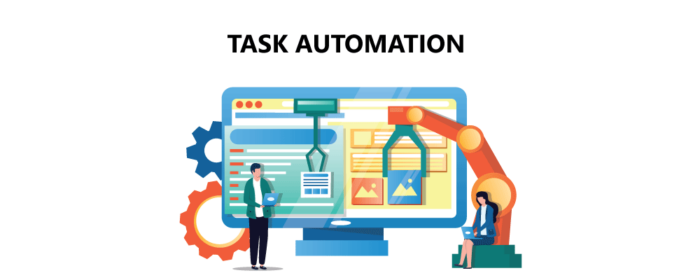
Efficiency is extremely important for businesses. Companies in every industry are laser-focused on maximizing productivity, reducing waste and costs, and getting more done with less effort and resources.
Luckily, new technologies emerging at a dizzying rate are providing powerful solutions to streamline operations and processes like never before. From smart automation to real-time data analytics to seamless connectivity, the tech tools at our fingertips are like secret weapons in the battle for greater efficiency.
Automating Routine Tasks

For businesses, few things are more inefficient than having highly skilled (and highly paid) employees get bogged down with tedious, repetitive tasks like data entry, document processing, scheduling, and reporting. Yet these types of rote administrative activities have long been productivity drains.
But thanks to robotic process automation (RPA) software powered by artificial intelligence and machine learning, those mundane rule-based digital tasks can now be intelligently automated from end-to-end with virtually no human intervention required.
RPA “bots” can log into applications, extract, and migrate data, trigger responses, and perform other multi-step processes with incredible speed, accuracy, and consistency compared to manual labor. And they can do it around the clock without breaks.
In industries like healthcare, finance, insurance, and supply chain management, RPA is a rapidly growing area allowing companies to automate swaths of back-office workloads so employees can focus on more complex, value-added activities.
Of course, AI automation doesn’t stop at routine digital tasks. Physical tasks like assembly, packaging, warehousing, and logistics are being transformed by smart factory robots and autonomous systems. These advanced technologies ensure maximum efficiency with machine-like accuracy and uninterrupted operation.
The efficiency gains of intelligently automating both white-collar office work and blue-collar operational tasks are staggering. And the capabilities keep expanding as AI and robotics technologies mature.
Predictive Analytics and Preventative Maintenance

Another huge efficiency killer is unplanned equipment failures, outages, and other disruptive incidents that grind operations to a halt and drain resources for emergency response and recovery efforts.
But what if you could predict when critical assets like industrial machinery, vehicles, or IT systems are likely to fail with enough lead time to take preventative maintenance or replacement actions? That’s exactly what new predictive analytics and Internet of Things (IoT) solutions provide.
IoT simply refers to embedding sensors, processing power, and connectivity into physical objects and equipment so they can collect and share real-time operational data. This could include details like temperature, vibration, energy usage, and much more.
Empowered by advanced analytics tools infused with machine learning algorithms, organizations can continually analyze all the streaming IoT sensor data to establish normal operational baselines and detect early warning signs of potential issues before significant problems arise.
So instead of equipment failing unexpectedly and causing catastrophic unplanned downtime, a factory can get alerted to an anomaly like rising temperature or excessive vibration and proactively schedule maintenance during regular downtime periods.
And it goes far beyond just industrial/manufacturing settings. Retail companies use predictive analytics on IoT sensor data to optimize inventory levels and forecast demand. Healthcare providers use it for remote patient monitoring and predictive care interventions.
Transportation and logistics firms predict traffic conditions and vehicle maintenance needs. The use cases span every sector.
Seamless Connected Operations and Workflows

Think about the last time you had to waste time hunting for a lost document or file, wait on an important update from a colleague, or manually re-enter the same data across multiple systems and tools. Those frustrating disconnects and redundant workloads are the epitome of inefficiency.
The antidote is connected technologies that allow for true seamless digital workflows, communication, and anytime collaboration between teams, partners, and customers, no matter where they’re located.
Thanks to cloud computing platforms and high-speed connectivity, companies can give employees secure access to all the apps, files, and data they need from any approved device or location. Work happens when and where it’s most convenient and efficient.
Cloud-based platforms also make it simpler for processes, activities, and data to flow smoothly between formerly siloed systems, departments, and organizations, boosting efficiency on a macro level.
According to the experts at Blues Wireless, cellular IoT devices are even automating asset monitoring and field service updates for remote facilities and teams.
Technologies like mobile devices and apps, videoconferencing, shared online workspaces, and workflow automation software further enhance collaboration efficiency by keeping teams in sync and on the same page in real-time with instantaneous updates and anytime, anywhere access.
Imagine service technicians instantly receiving maintenance requests through their mobile device as soon as a customer submits a ticket through another application, with AI assistance helping automatically classify and route issues.
The tech can then order required parts, retrieve documentation, and coordinate with on-site teams through mobile video chat before even arriving for faster resolution.
Or salespeople automatically receiving live updates of product inventory levels, pricing changes, and customer details as they’re meeting with prospective buyers.
In these scenarios, connected tools working in harmony slash delays, inefficient manual hand-offs, context-switching, and mistakes that stall productivity. They enable a seamless, integrated, and efficient digital workflow.
Where Humans and Technology Intersect

It’s important to be aware that technology alone doesn’t magically solve all efficiency challenges. These powerful tools must be tailored, implemented, and utilized by knowledgeable human teams in smart ways aligned with business goals.
Poor technology adoption and change management will diminish the efficiency returns.
There are also concerns around algorithmic bias in AI automation and data privacy/security risks in hyperconnected environments that must be thoughtfully mitigated.
But when organizations can synergize human expertise with the tireless speed, consistency, scalability, and insight-generating capabilities of emerging technologies like AI, IoT, predictive analytics, and seamless cloud connectivity, digital transformation manifests into tangible, sustainable efficiency gains.
Conclusion
An exciting future awaits companies willing to thoughtfully implement these technologies and develop complementary human skill sets around managing data, analyzing insights, collaborating across functions, and iterating on digitally optimized workflows.
Those leading businesses will outpace and outperform efficiency-wise, unlocking new competitive advantages. Efficiency is no longer a luxury but a necessity for survival and growth in our hyper-connected global economy. Technology is crucial for constantly improving it.














